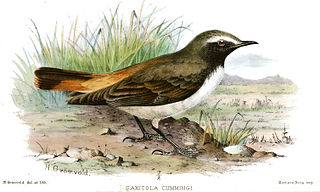
The isabelline wheatear is a small passerine bird that was formerly classed as a member of the thrush family Turdidae, but is now more generally considered to be an Old World flycatcher in the family Muscicapidae. It is a migratory insectivorous bird. Its habitat is steppe and open countryside and it breeds in southern Russia and Central Asia to northern Pakistan, wintering in Africa and northwestern India. It is a very rare vagrant to western Europe.

The desert wheatear is a wheatear, a small passerine bird that was formerly classed as a member of the thrush family Turdidae, but is now more generally considered to be an Old World flycatcher (Muscicapidae). It is a migratory insectivorous species, 14.5 to 15 cm in length. Both western and eastern forms of the desert wheatear are rare vagrants to western Europe. The western desert wheatear breeds in the Sahara and the northern Arabian peninsula. The eastern race is found in the semi-deserts of Central Asia and in winter in Pakistan and northeast Africa.

The western black-eared wheatear is a wheatear, a small migratory passerine bird that was formerly classed as a member of the thrush family Turdidae, but is now considered to be an Old World flycatcher. It was formerly considered conspecific with the eastern black-eared wheatear.

The pied wheatear is a wheatear, a small insectivorous passerine bird that was formerly classed as a member of the thrush family Turdidae, but is now more generally considered to be an Old World flycatcher. This migratory central Asiatic wheatear occurs from the extreme southeast of Europe to China, and has been found wintering in India and northeastern Africa. It is a very rare vagrant to western Europe.

The northern wheatear or wheatear is a small passerine bird that was formerly classed as a member of the thrush family Turdidae, but is now more generally considered to be an Old World flycatcher, Muscicapidae. It is the most widespread member of the wheatear genus Oenanthe in Europe and North and Central Asia.

The pin-tailed sandgrouse is a medium large bird in the sandgrouse family. It has a small, pigeon like head and neck and a sturdy, compact body. It has long pointed wings, which are white underneath, a long tail and a fast direct flight. Flocks fly to watering holes at dawn. The call is a loud kattar-kattar. This gregarious species breeds on dry open treeless plains and similar habitats. Its nest is a ground scrape into which two or three cream-coloured eggs with cryptic markings are laid. Both sexes incubate the eggs.

The hooded wheatear is a wheatear, a small insectivorous passerine that was formerly classed as a member of the thrush family Turdidae, but is now more generally considered to be an Old World flycatcher, Muscicapidae.

Finsch's wheatear is a wheatear, a small insectivorous passerine that was formerly classed as a member of the thrush family, Turdidae, but is now more generally considered to be an Old World flycatcher of the family Muscicapidae.

The chestnut-bellied sandgrouse or common sandgrouse is a species of sandgrouse. It is a sedentary and nomadic species that ranges from northern and central Africa and further east towards western and southern Asia. There are six recognised subspecies.

Carola's parotia, also known as Queen Carola's six-wired bird-of-paradise or Queen Carola's parotia, is a species of bird-of-paradise.

The capped wheatear is a small insectivorous passerine bird that was formerly classed as a member of the thrush family Turdidae, but is now more generally considered to be an Old World flycatcher, Muscicapidae.

The red-rumped wheatear or buff-rumped wheatear is a species of bird in the family Muscicapidae. It is found in North Africa and the Middle East.

The variable wheatear is a species of bird in the family Muscicapidae. It is found in Afghanistan, Egypt, India, Iran, Kazakhstan, Lebanon, Nepal, Oman, Pakistan, Russia, Tajikistan, Turkmenistan, the United Arab Emirates, and Uzbekistan.

The Kurdish wheatear, also known as the Kurdistan wheatear, the chestnut-rumped wheatear or the red-rumped wheatear, is a species of bird in the family Muscicapidae. The red-tailed wheatear was formerly considered a subspecies of this bird but is now often regarded as a separate species. The two may intergrade in Iran but it is also possible that the rather differently coloured cummingi is in fact a one-year-old O. xanthoprymna with intermediate plumage.

The baglafecht weaver is a species of weaver bird from the family Ploceidae which is found in eastern and central Africa. There are several disjunct populations with distinguishable plumage patterns. Only some races display a discrete non-breeding plumage.

The scarlet-backed woodpecker is a species of bird in the family Picidae. It is found in Colombia, Ecuador and northern Peru where its natural habitats are subtropical or tropical dry forests and subtropical or tropical dry shrubland. It is listed by the International Union for Conservation of Nature as being a species of "least concern".

The red-tailed wheatear, also known as the rusty-tailed wheatear, Persian wheatear or Afghan wheatear, is a small passerine bird breeding in mountainous areas of south-west and central Asia. It belongs to the wheatear genus Oenanthe which was formerly placed in the thrush family Turdidae but is now in the Old World flycatcher family Muscicapidae. The red-tailed wheatear used to be considered a subspecies of the Kurdish wheatear but is now often regarded as a separate species.

The black-fronted bushshrike is a passerine bird of the bushshrike family, Malaconotidae. It inhabits forests mainly in East Africa. It forms a superspecies with the many-colored bushshrike and the two are sometimes considered to be a single species.

Heuglin's wheatear is a small passerine bird in the wheatear genus Oenanthe.

The Atlas wheatear, also known as the black-throated wheatear or Seebohm's wheatear, is a small passerine bird which breeds in the Maghreb region of North Africa and winters in the western Sahel. It was formerly considered a subspecies of the northern wheatear as O. o. seebohmi, but was reclassified as a distinct species by the IOC in 2021.





















